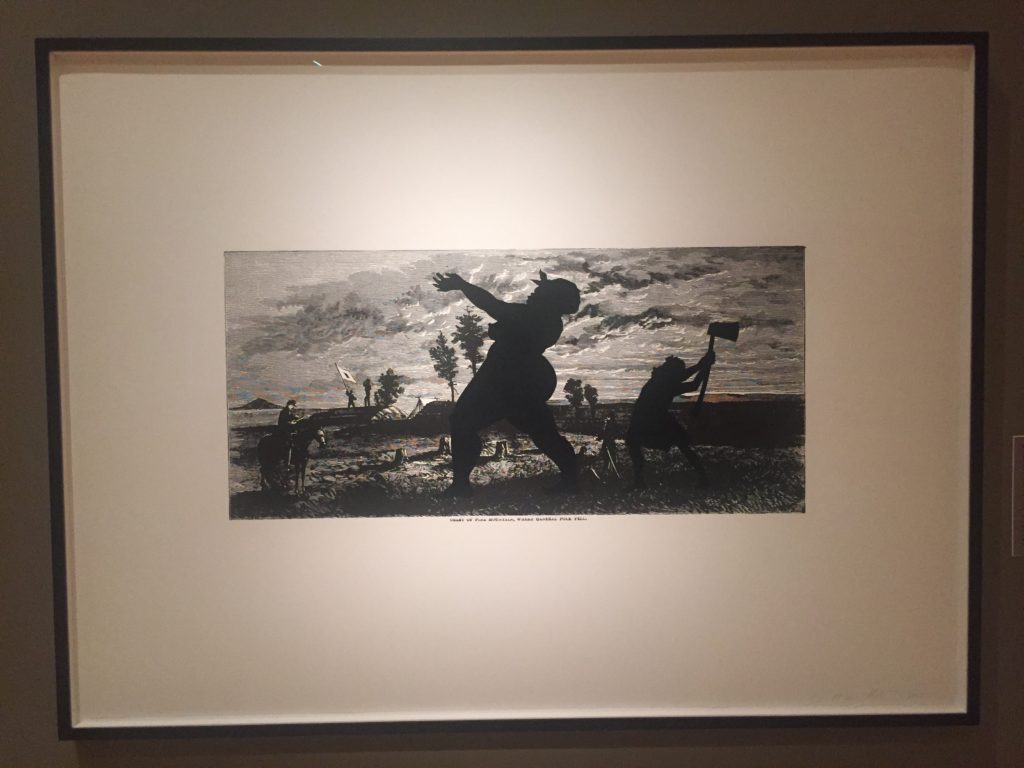The New Britain Museum of American Art (NBMAA) recently acquired the work “Harper’s Pictorial History of the Civil War (Annotated), 15 large-scale lithograph and screenprints, striking and evocative compositions, by the contemporary, African-American artist Kara Walker. As part of the museum’s year-long celebration of exhibitions espousing the impact of 7 remarkable and groundbreaking women artists, it is fitting to open the series with Walker and her pioneering work that “explores race, gender, identity, and American history.” What is so delightful about the Walker exhibition is it offers you, the viewer, to experience her work in the context of objects of art, other representations, and perspectives of the Civil War, including paintings by Winslow Homer, within the museum’s collection.

In the series, Walker interrogates the narrative of the Black experience during the Civil War, Her medium? A revisitation of 19th-century portrait profiles of the upper and middle class- cut-outs or silhouettes. The stark, black, cut out figure forms representing black figures or as Walker describes, “looking like me,” are overlayed upon chosen scenes from the publication, published in 1866, Harper’s ( Harper’s Pictorial History of the Civil War). The intention of the lavishly illustrated pages, boasting of over 1.000 images, scene maps, and portraits, was to recount the of the events of war “just as they occurred.” Walker “visually disrupts the original images and suffuses them with traumatic scenarios left out of the “official” record.”
Walker’s aim is “to suggest perspectives left out of the record.” They alter dramatically the events Harper’s depicted; the juxtaposition of “shadowy, blatantly stereotypical features with precise, detailed features of African-American figures portrays and more importantly reflects the racial history of the South.” (from Browsings, The Harper’s Blog, Jan., 2020)
One of my favorite individual pieces in the series is “Crest of Pine Mountain, Where General Polk Fell, from “Harper’s Pictorial History of the Civil War (Annotated),” 2005. The woodcut print depicts a scene in 1864 when Union troops entered Georgia “in a campaign to take the strategic city of Atlanta.” The vista of Pine Mountain, where the battle took place, is both a beautiful and harrowing image. Below a river of clouds, placed in the center of the print is four tree stumps. They appear to me as grave markers, illustrating the loss of anonymous soldiers. Atop the print, dominant in size and stature, is a black woman, her black silhouette braces the scene with raised undulating arms, a kerchief wrapped around her head links to the “mammy” stereotype. I sense in her raised arms the indelible loss of the battle, the tearing up of nature’s beauty. Behind the dominant woman, a girl swings an ax–“a reference, perhaps to all those fallen in war.”
You can view “Harper’s Pictorial History of the Civil War (Annotated)” at New Britain Museum of American Art, until April 19, 2020. A link to their website: https://nbmaa.org/.
I am a big fan of the PBS series Art21 that takes a deep dive into the artistic practice by contemporary artists. In this video, she describes the “turbulence” in her work, claiming the “silhouette” medium lends to the “avoidance” of the subject. So powerful!! The video is a short preview of the full episode. Click the link for more videos and conversations by Kara Walker. https://art21.org/artist/kara-walker/
